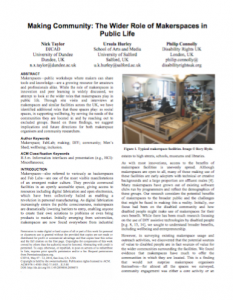
We’re very happy to have had a paper accepted into CHI 2016 based on the makerspaces survey we carried out in the early stages of In the Making.
The pre-print is now available to download.
Summary
Makerspaces are a growing resource for amateurs and professionals alike. While the role of makerspaces in innovation and peer learning is widely discussed, we attempt to look at the wider roles that makerspaces play in public life. Through site visits and interviews at makerspaces and similar facilities across the UK, we have identified additional roles that these spaces play: as social spaces, in supporting wellbeing, by serving the needs of the communities they are located in and by reaching out to excluded groups. Based on these findings, we suggest implications and future directions for both makerspace organisers and community researchers.
Findings
We found evidence of four roles played by makerspaces in their communities:
Social spaces. Although there is often an emphasis on the equipment (at least from external parties), makerspaces themselves valued the community within the space more than anything else. The equipment was seen as a hook, and often something that could easily be replicated at home, while the community within the space was something people stayed for.
Serving local needs. There was a lot of evidence to suggest that makerspaces tailor their offerings to the local area. A number were located in areas with high unemployment and saw themselves as providing skills that would be useful to nearby industries, including through formal internship and training. One of the most notable examples was in Northern Ireland where makerspaces were set up by the government as part of the reconciliation process.
Wellbeing and empowerment. We found many examples of makerspaces acting as safe, creative spaces where people could express themselves and develop skills and confidence. As well as ‘proper’ makerspaces, we visited a Men’s Shed that best exemplified this, having a explicit but covert goal of supporting mental health in older men.
Widening access. Finally, all of the makerspaces were engaged in some form of outreach that attempted to make their facilities accessible to people who fell outside the maker stereotype, including children and disabled people. However, real challenges exist in making this a reality, including a lack of resources and deeply ingrained beliefs in excluded segments of society about whether they ‘fit’.
PhD Opportunity
I’m also currently advertising for a PhD student who will pick up this thread of work and continue examining the different ways that makerspaces and Men’s Sheds can support community and wellbeing. This paper is really only a starting point, indicating surface-level areas of opportunity, and there is much more work to be done in understanding these opportunities and how we can harness them.
Leave a Reply